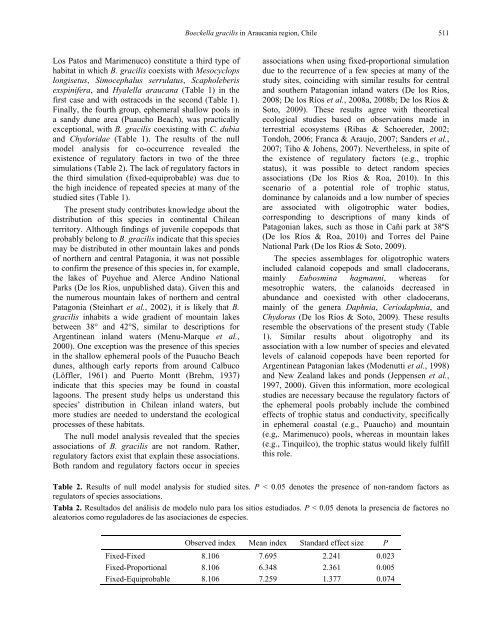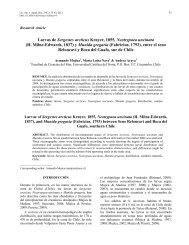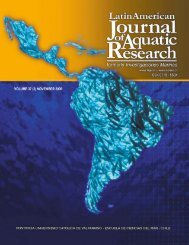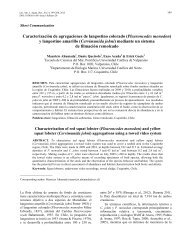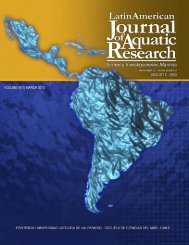Portada LAJAR.psd - Latin American Journal of Aquatic Research
Portada LAJAR.psd - Latin American Journal of Aquatic Research
Portada LAJAR.psd - Latin American Journal of Aquatic Research
You also want an ePaper? Increase the reach of your titles
YUMPU automatically turns print PDFs into web optimized ePapers that Google loves.
Los Patos and Marimenuco) constitute a third type <strong>of</strong><br />
habitat in which B. gracilis coexists with Mesocyclops<br />
longisetus, Simocephalus serrulatus, Scapholeberis<br />
exspinifera, and Hyalella araucana (Table 1) in the<br />
first case and with ostracods in the second (Table 1).<br />
Finally, the fourth group, ephemeral shallow pools in<br />
a sandy dune area (Puaucho Beach), was practically<br />
exceptional, with B. gracilis coexisting with C. dubia<br />
and Chydoridae (Table 1). The results <strong>of</strong> the null<br />
model analysis for co-occurrence revealed the<br />
existence <strong>of</strong> regulatory factors in two <strong>of</strong> the three<br />
simulations (Table 2). The lack <strong>of</strong> regulatory factors in<br />
the third simulation (fixed-equiprobable) was due to<br />
the high incidence <strong>of</strong> repeated species at many <strong>of</strong> the<br />
studied sites (Table 1).<br />
The present study contributes knowledge about the<br />
distribution <strong>of</strong> this species in continental Chilean<br />
territory. Although findings <strong>of</strong> juvenile copepods that<br />
probably belong to B. gracilis indicate that this species<br />
may be distributed in other mountain lakes and ponds<br />
<strong>of</strong> northern and central Patagonia, it was not possible<br />
to confirm the presence <strong>of</strong> this species in, for example,<br />
the lakes <strong>of</strong> Puyehue and Alerce Andino National<br />
Parks (De los Ríos, unpublished data). Given this and<br />
the numerous mountain lakes <strong>of</strong> northern and central<br />
Patagonia (Steinhart et al., 2002), it is likely that B.<br />
gracilis inhabits a wide gradient <strong>of</strong> mountain lakes<br />
between 38° and 42°S, similar to descriptions for<br />
Argentinean inland waters (Menu-Marque et al.,<br />
2000). One exception was the presence <strong>of</strong> this species<br />
in the shallow ephemeral pools <strong>of</strong> the Puaucho Beach<br />
dunes, although early reports from around Calbuco<br />
(Löffler, 1961) and Puerto Montt (Brehm, 1937)<br />
indicate that this species may be found in coastal<br />
lagoons. The present study helps us understand this<br />
species’ distribution in Chilean inland waters, but<br />
more studies are needed to understand the ecological<br />
processes <strong>of</strong> these habitats.<br />
The null model analysis revealed that the species<br />
associations <strong>of</strong> B. gracilis are not random. Rather,<br />
regulatory factors exist that explain these associations.<br />
Both random and regulatory factors occur in species<br />
Boeckella gracilis in Araucania region, Chile<br />
511<br />
associations when using fixed-proportional simulation<br />
due to the recurrence <strong>of</strong> a few species at many <strong>of</strong> the<br />
study sites, coinciding with similar results for central<br />
and southern Patagonian inland waters (De los Ríos,<br />
2008; De los Ríos et al., 2008a, 2008b; De los Ríos &<br />
Soto, 2009). These results agree with theoretical<br />
ecological studies based on observations made in<br />
terrestrial ecosystems (Ribas & Schoereder, 2002;<br />
Tondoh, 2006; Franca & Araujo, 2007; Sanders et al.,<br />
2007; Tiho & Johens, 2007). Nevertheless, in spite <strong>of</strong><br />
the existence <strong>of</strong> regulatory factors (e.g., trophic<br />
status), it was possible to detect random species<br />
associations (De los Ríos & Roa, 2010). In this<br />
scenario <strong>of</strong> a potential role <strong>of</strong> trophic status,<br />
dominance by calanoids and a low number <strong>of</strong> species<br />
are associated with oligotrophic water bodies,<br />
corresponding to descriptions <strong>of</strong> many kinds <strong>of</strong><br />
Patagonian lakes, such as those in Cañi park at 38ºS<br />
(De los Ríos & Roa, 2010) and Torres del Paine<br />
National Park (De los Ríos & Soto, 2009).<br />
The species assemblages for oligotrophic waters<br />
included calanoid copepods and small cladocerans,<br />
mainly Eubosmina hagmanni, whereas for<br />
mesotrophic waters, the calanoids decreased in<br />
abundance and coexisted with other cladocerans,<br />
mainly <strong>of</strong> the genera Daphnia, Ceriodaphnia, and<br />
Chydorus (De los Ríos & Soto, 2009). These results<br />
resemble the observations <strong>of</strong> the present study (Table<br />
1). Similar results about oligotrophy and its<br />
association with a low number <strong>of</strong> species and elevated<br />
levels <strong>of</strong> calanoid copepods have been reported for<br />
Argentinean Patagonian lakes (Modenutti et al., 1998)<br />
and New Zealand lakes and ponds (Jeppensen et al.,<br />
1997, 2000). Given this information, more ecological<br />
studies are necessary because the regulatory factors <strong>of</strong><br />
the ephemeral pools probably include the combined<br />
effects <strong>of</strong> trophic status and conductivity, specifically<br />
in ephemeral coastal (e.g., Puaucho) and mountain<br />
(e.g,. Marimenuco) pools, whereas in mountain lakes<br />
(e.g., Tinquilco), the trophic status would likely fulfill<br />
this role.<br />
Table 2. Results <strong>of</strong> null model analysis for studied sites. P < 0.05 denotes the presence <strong>of</strong> non-random factors as<br />
regulators <strong>of</strong> species associations.<br />
Tabla 2. Resultados del análisis de modelo nulo para los sitios estudiados. P < 0.05 denota la presencia de factores no<br />
aleatorios como reguladores de las asociaciones de especies.<br />
Observed index Mean index Standard effect size P<br />
Fixed-Fixed 8.106 7.695 2.241 0.023<br />
Fixed-Proportional 8.106 6.348 2.361 0.005<br />
Fixed-Equiprobable 8.106 7.259 1.377 0.074


